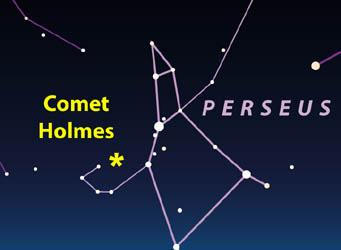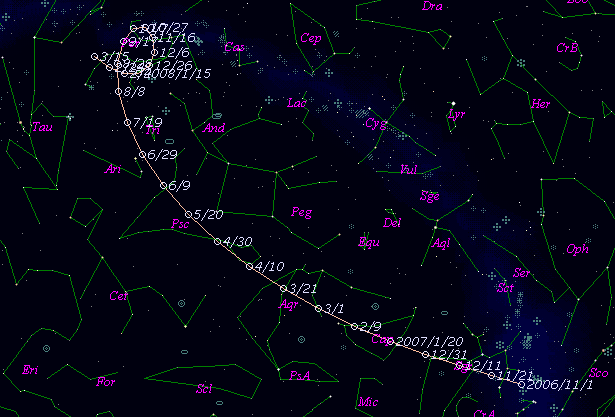Sudden Naked-Eye Comet Shocks the Astronomy World

A distant comet that was as faint as magnitude 18 on October 20th has suddenly brightened by a millionfold, altering the naked-eye appearance of the constellation Perseus.
This startling outburst of Comet Holmes (17P) is even stronger than the one that occurred 115 years ago, in November 1892, when the comet was first spotted by English amateur Edwin Holmes.
According to IAU Circular 8886, issued Wednesday October 24th by the Central Bureau for Astronomical Telegrams in Cambridge, Massachusetts, A. Henriquez Santana at Tenerife, Canary Islands, was the first to notice the outburst shortly after local midnight on the 24th. The comet was then about 8th magnitude, but within minutes Ramon Naves and colleagues in Barcelona, Spain, caught it at magnitude 7.3.
Internet discussion groups came alive with the news. "To my amazement, 17P had brightened to naked-eye visibility," exclaimed Bob King when he spotted Comet Holmes shortly before dawn in Duluth, Minnesota. "What a sight!" he posted to the Comets Mailing List. Alan Hale of Cloudcroft, New Mexico, concurred. To Hale (well-known codiscoverer of Comet Hale-Bopp) it appeared essentially starlike in a telescope until he switched to high power.
Then things only got better. As Earth continued to turn, nightfall arrived in Japan. "It is visible with naked eyes in a large city!" posted Seiichi Yoshida, who observed the comet from beside Tsurumi River in Yokohama. By 17:15 Universal Time he was describing Comet Holmes as magnitude 2.8.
Comet expert Gary Kronk expects this object to remain bright and grow from a starlike point to several arcminutes across over the next few nights as it makes its way slowly westward across Perseus. Its position on October 25th (0h UT) is right ascension 3h 53m, declination +50.1° (equinox 2000), and by October 30th it will have moved only to 3h 48m, +50.4°. For those living in the Northern Hemisphere, Perseus is visible all night at this time of year.
Update Thursday Oct. 25: "This object is amazing!" posted Brian Cudnik of Houston, Texas, on the Yahoo CometChasing group after coming in from his telescope on the evening of the 24th. "I have just observed it with an 8-inch f/10 Cassegrain, boosting the power up to 163x then to 508x.... The bright inner coma seems displaced off-center toward position angle 315°. The inner coma opens up into a fan toward position angle 300°, and I have noticed one ripple, akin to the hoods/ripples seen in Comet Hale-Bopp ten years ago. The coma is uniform in brightness, aside from this fan-shape material emanating from the central condensation, and has a well-defined edge." He measured the coma to be 69 arcseconds wide using using the drift method. "The entire object has a nice yellow-white color; no sign of any tail. The apparent magnitude is +2.8 (estimated using Mirfak at +1.9 and the other two bright stars adjacent to it at +3.0 each) and has remained rather steady all evening."
Posted Dan Laszlo of Fort Collins, Colorado: "In an 18-inch Newtonian at 90x, the yellow orb is like a bright spherical planetary nebula. Diameter of the bright portion is about equal to the lunar crater Tycho, so magnification helps. I can detect a very faint spherical outer envelope, about equal in radius to the diameter of the bright portion, tough with the moonlight."
From Florian Boyd, Palm Springs, California: "I think this is about the most amazing thing I've ever seen in the sky!"
Pictures and more pictures.
Chart and ephemeris of its future motion.

Update Thursday evening: From S&T's Alan MacRobert: "Omigod. Through thin clouds lit by the full Moon I had to guess where Perseus was, but I swept around with 10x50 binoculars, and wham, there was the comet! It's sure not starlike now, at least not in the 10x binocs with homemade image stabilization. It's a very sizeable bright fuzz spot, perfectly round, with a large, brilliant, hazy nucleus and a very sharp edge to the circular coma. Golden yellow with just a hint of green.
"When the clouds finally cleared and I could see it with the naked eye, it was still starlike to my vision. Magnitude 2.6 or 2.7, based on Alpha Persei mag. 1.8 and Delta Per mag. 3.0."
Posted by Roger W. Sinnott, October 24, 2007
http://www.skyandtelescope.com/observing/home/10775326.html
'별보기 > 하늘 소식' 카테고리의 다른 글
| Amazing Space: Tonight's Sky 2008, 01 (0) | 2008.01.23 |
|---|---|
| 07년 제19회 한국 아마추어 천문인의 밤 '별잔치 (STAR PARTY) (0) | 2007.11.02 |
| 2007.8.28 Total Eclipse(개기월식) (0) | 2007.08.23 |
| 페르세우스자리 유성우 (0) | 2007.08.09 |
| 2007년 7월의 천문현상 (0) | 2007.07.12 |
